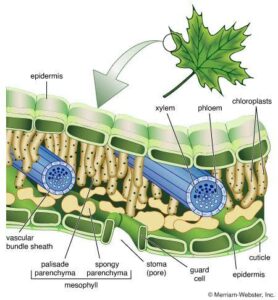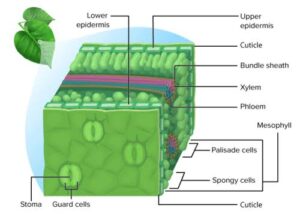Back to: Botany 300 Level
Hello, my brilliant friend! I hope you’re having a fantastic day! Have you ever wondered how leaves help plants grow? Or why some leaves feel smooth while others have tiny holes when you look closely? Today, we’ll learn about the structure of leaves and how each part helps the plant stay alive and healthy.
Leaf structure: mesophyll, vascular bundle, stomata
Understanding the Structure of a Leaf
A leaf is like a solar panel for a plant. It captures sunlight to make food through photosynthesis. But for this to happen, different parts of the leaf work together. The main structures we’ll focus on are:

Mesophyll – The inner tissue where photosynthesis happens.
Vascular Bundle – The transport system of the leaf (xylem and phloem).
Stomata – Tiny openings that allow gas exchange.
Let’s look at each one closely!
Mesophyll: The Food Factory
The mesophyll is the inner part of the leaf, where most of the plant’s food is made. It has two layers:
Palisade Mesophyll – A layer of tightly packed cells near the upper surface of the leaf. These cells contain chloroplasts, which absorb sunlight for photosynthesis.
Spongy Mesophyll – Loosely arranged cells below the palisade layer. They have air spaces that allow gases (oxygen, carbon dioxide) to move in and out of the leaf.
Think of the mesophyll as a school classroom:
The palisade layer is like students sitting upright, focusing on absorbing sunlight.
The spongy layer is like students walking around, allowing air to flow freely.
Without mesophyll, a plant cannot make its own food!
Vascular Bundle: The Transport Highway
The vascular bundle is the transport system of the leaf, made up of two important tissues:
Xylem – Carries water and minerals from the roots to the leaf.
Phloem – Transports food (glucose) from the leaf to other parts of the plant.
This system works just like our blood vessels, delivering nutrients where they are needed!
Stomata: The Leaf’s Tiny Mouths
Have you ever noticed tiny holes under a leaf? These are stomata (singular: stoma), and they act like the leaf’s breathing system!
Stomata open during the day to take in carbon dioxide (for photosynthesis) and release oxygen.

They close at night or when it’s too hot to prevent water loss.
Each stoma is controlled by guard cells, which act like tiny doors—opening and closing when needed.
A Simple Story to Understand This Concept
Imagine a leaf as a kitchen:
The mesophyll is the chef, making food for the plant.
The vascular bundle is the waiter, delivering water and taking food to other parts.
The stomata are the windows, letting in fresh air and releasing oxygen.
Each part plays a role in keeping the plant healthy and growing!
Summary
Mesophyll is where photosynthesis happens, with palisade and spongy layers.
Vascular bundles (xylem and phloem) transport water and food.
Stomata are tiny pores that control gas exchange.
Guard cells regulate when stomata open and close.
Evaluation
- What is the function of the mesophyll?
- How do xylem and phloem help the leaf?
- Why do stomata open during the day?
- What is the difference between palisade and spongy mesophyll?
- How do guard cells help the plant conserve water?
You are doing an amazing job! Now, the next time you see a leaf, you’ll know exactly how it works! Keep learning with Afrilearn, and I’ll see you in the next exciting lesson. Stay curious and keep growing!
